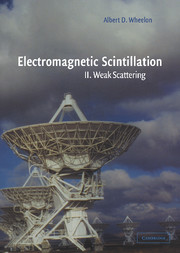Book contents
- Frontmatter
- Contents
- Preface
- 1 Introduction
- 2 The Rytov Approximation
- 3 Amplitude Variance
- 4 Spatial Covariance
- 5 The Power Spectrum and Autocorrelation
- 6 Frequency Correlations
- 7 Phase Fluctuations
- 8 Double Scattering
- 9 Field-strength Moments
- 10 Amplitude Distributions
- 11 Changes in Polarization
- 12 The Validity of the Rytov Approximation
- Appendix A Glossary of Symbols
- Appendix B Integrals of Elementary Functions
- Appendix C Integrals of Gaussian Functions
- Appendix D Bessel Functions
- Appendix E Probability Distributions
- Appendix F Delta Functions
- Appendix G Kummer Functions
- Appendix H Hypergeometric Functions
- Appendix I Aperture Averaging
- Appendix J Vector Relations
- Appendix K The Gamma Function
- Appendix L Green's Function
- Appendix M The Method of Cumulant Analysis
- Appendix N Diffraction Integrals
- Appendix O Feynman Formulas
- Author Index
- Subject Index
5 - The Power Spectrum and Autocorrelation
Published online by Cambridge University Press: 15 December 2009
- Frontmatter
- Contents
- Preface
- 1 Introduction
- 2 The Rytov Approximation
- 3 Amplitude Variance
- 4 Spatial Covariance
- 5 The Power Spectrum and Autocorrelation
- 6 Frequency Correlations
- 7 Phase Fluctuations
- 8 Double Scattering
- 9 Field-strength Moments
- 10 Amplitude Distributions
- 11 Changes in Polarization
- 12 The Validity of the Rytov Approximation
- Appendix A Glossary of Symbols
- Appendix B Integrals of Elementary Functions
- Appendix C Integrals of Gaussian Functions
- Appendix D Bessel Functions
- Appendix E Probability Distributions
- Appendix F Delta Functions
- Appendix G Kummer Functions
- Appendix H Hypergeometric Functions
- Appendix I Aperture Averaging
- Appendix J Vector Relations
- Appendix K The Gamma Function
- Appendix L Green's Function
- Appendix M The Method of Cumulant Analysis
- Appendix N Diffraction Integrals
- Appendix O Feynman Formulas
- Author Index
- Subject Index
Summary
The amplitudes of signals passing through the atmosphere change with time in a random manner. The amplitude time history for a microwave signal is reproduced in Figure 5.1 from an early experiment. This rapid variability is due primarily to scattering by irregularities that are being carried through the illuminated volume on prevailing winds. To a lesser extent, it is caused by rearrangement of the irregularities by turbulent mixing and the intrinsic process of subdivision that creates the spectrum, as suggested in Figure 2.5 of Volume 1. Variability of signal amplitude is an important consideration for communication systems and target-location systems. It provides a significant tool for atmospheric scientists and astronomers who exploit it to study the properties of remote regions.
We presented several techniques for describing a moving and evolving turbulent atmosphere in Section 6.1 of Volume 1. The vast majority of propagation studies rely on Taylor's hypothesis to describe the temporal changes that occur in a random medium. This approximation involves two assumptions. It is postulated that the entirety of the turbulent medium is frozen during the measurement interval. It is also assumed that one can ignore the variable component of velocity and that the wind velocity is constant at each location. In combination, these two assumptions imply that the entire air mass is transported at constant speed without being deformed as suggested in Figure 6.2 of Volume 1.
- Type
- Chapter
- Information
- Electromagnetic Scintillation , pp. 167 - 187Publisher: Cambridge University PressPrint publication year: 2003



